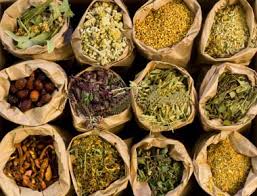Healing Herbs for the Postpartum Period
Healing Herbs for the Postpartum Period

by Katharina Bishop
Hydrotherapy is the use of water for treatment of illness. It involves the curative use of mineral water and herbal bath additives and is especially popular in Europe, where it has a long history of use in health spas and therapeutic centres. Sitzbaths are a form of hydrotherapy which is especially beneficial in the postpartum period. To prepare a sitzbath, fill your bathtub with four inches of warm water and add healing herbs following the recipes below.
Soothing herbs are added to a sitzbath to speed the healing of the perineum after childbirth. This is especially helpful if a laceration or episiotomy has occurred, or if there are hemorrhoids. Specially selected dried herbs are brewed into a strong tea which is added to the bathwater. Herbs can facilitate the repair, tightening and toning of the tissue as well as decreasing swelling and pain. In addition, they have antiseptic properties which prevent infection.
Herbal sitzbath mixtures for postpartum healing are easily prepared at home using either of the following two recipes.
Yarrow flowers, Uva Ursi, Witch Hazel or Oak Bark act as astringents. They tighten the tissue and decrease swelling. Plaintain leaves, Comfrey leaves and Calendula flowers facilitate tissue repair. Slippery Elm Bark sooths and nourishes the tissue. Myrrh gum powder acts as an anti-microbial agent. Lavender flowers, rose petals, sea salt and garlic are known for their antiseptic properties.
Recipe 1
Ingredients
- 1 ounce uva ursi leaves
- 1 ounce myrrh gum powder
- 1/3 ounce shredded slippery elm bark
- 1/3 ounce comfrey leaves
- 12 chopped cloves of fresh garlic
- 1 cup sea salt
Directions
Boil one gallon of water. Place the herbs and chopped garlic in a clean 1 gallon glass jar or metal pot. Pour the boiling hot water over the herbs (do not boil the herbs), cover and let stand until cool. Strain the herbal infusion soon after it is cool.
Pour 1/2 of the strained tea plus 1/2 cup of the salt into a sitzbath tub or a clean bathtub and add warm water (to comfort) until four to six inches deep. Soak in the bath for about 30 minutes. Do not rinse off the herbal infusion, just pat yourself dry after the bath. Continue the sitzbaths for at least three days after the birth, twice a day. This recipe yields two baths.
Recipe 2
Ingredients
- 2 ounces of yarrow flowers (alternatively, substitute uva ursi, witch hazel or oak bark)
- 2 ounces of plaintain leaves (alternatively, substitute comfrey leaves or calendula flowers)
- 1 ounce lavender flowers or rose petals
Directions
This recipe will yield two batches of herbal sitzbath preparations. Divide the herbs in half, reserving one half for later. Place the herbs in a pan with 8 cups of water. Bring to a boil, turn off the heat immediately, cover, and leave to steep for at least 30 minutes, or overnight.
Reheat. Reserve one cup of the liquid to use later as a compress. Strain the herbal preparation into a sitzbath tub or a clean bathtub and add four inches of warm water. The water should be as warm as your skin can tolerate. Soak for 15 – 20 minutes.
Wait for a few hours, then reheat the reserved cup of herbal infusion, dip a clean cloth or gauze pad in it and apply to the perineum for 10 – 20 minutes, re-dipping it in the infusion as often as needed to ensure it stays hot.
Use the sitzbath and compresses one to three times daily. If you choose to use comfrey, do not use for longer than three days and be sure to use the comfrey leaves, not the root.
Always consult your midwife or other health care provider before using any herbal preparations.

